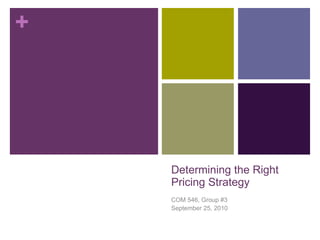Determining the Right Pricing Strategy
- 1. Determining the Right Pricing Strategy COM 546, Group #3 September 25, 2010
- 2. Cost-Oriented Pricing Examples: Markup pricing: found in retail trades where the retailer adds predetermined but different markups to various goods Cost-plus pricing: describes pricing of jobs that are non-routine and difficult to “cost” in advance (i.e., market research, many services) Organizational Example: Red Cross charges a price for its blood that covers irreducible cost of recruiting, processing, collecting and distributing blood to hospital *Some non-profit org charge less than costs ( cost-minus pricing ) Setting prices largely on the basis of costs, either marginal costs or total costs including overhead
- 3. Cost-Oriented Pricing (continued) Popular form of cost-orientated pricing uses break-even analysis “How many unites of an item would have to be sold to cover fully the costs” –> this is the break-even volume Formula: Break even volume = Fixed Cost Price – variable cost Pros: Popular because there is less uncertainty about costs than about demand Also easier to implement for org that have many items to price Cons: Ignores how valuable the offering is to target audiences
- 4. Value-Based Pricing Looks at strength and nature of demand rather than the level of costs to set the price Price should reflect the perceived value in the audience’s head Cons: Difficult to learn what target audience members would pay for a given product or service The ethics involved with raising prices on basic necessity type items (i.e., medicines)
- 5. Competition-Oriented Pricing Pricing based on alternative organizations (i.e., a rival museum) A non-profit marketer may choose to charge the same as the competition, a higher price, or a lower price Distinguishing characteristic is that the organization does not seek to maintain a rigid relation between its price and its own costs or demand Its own costs or demands may change, but the organization maintains its price because competitors maintain their prices
- 6. Sliding Scale Pricing Sliding scale pricing is when products or services are priced differently based on individual attributes such as one’s ability to pay, age, location, etc. Sliding scales often give opportunities to people who may not be able to afford certain products or services otherwise Example: Medical fees. Medical fees often vary based on financial income
- 7. Sliding Scale Pricing To be a “good Samaritan” to those less fortunate To receive a tax deduction for offering charitable services To retain customers To get existing customers to refer new ones It’s often possible to still turn a profit even though the price is lower Why would an organization use a sliding scale pricing system?
- 8. Sliding Scale Pricing Some other organizations that often use sliding scale pricing are: Adoption agencies Law firms Educational establishments Healthcare establishments Sliding scales are most often used by non-profits. However, this is not always the case.
- 9. Promotional Pricing Specials in pricing that are designed to encourage increased buying. This practice is extremely common in the private sector.
- 10. Examples of Promotional Pricing Series or bulk discounts Examples: “see five plays for the price of four” at a local theater; get a free night at Seaworld hotel when you buy two “ Early bird” discounts Examples: subscribe early to a theater group’s series and get a percentage off; earn free tickets to the NC State Fair when you buy tickets before October Percentage discounts Examples: get a second ticket to a performance for half off; buy one pair of shoes, get the second for half off Last minute discounts Examples: get unsold tickets the day of a performance for half price; get unsold flights and hotels for 60% discounts if you travel in the next 30 days
- 11. Triangle Family Services (TFS) TFS provides individuals and families with resources to transition from crisis to stable and healthy life situations A United Way organization, TFS has operated in the Raleigh-Durham area since 1937 TFS provides help for more than 7,000 individuals and families each year Services are offered in areas of: Mental Health Family Safety Financial Stability
- 12. Triangle Family Services (TFS) For the Individual Therapy (45-50 min) service the organization offers: Cost-Oriented Pricing: TFS would charge exactly how much it costs to have the therapist for 50 minutes do the session as well as an hour of time for the building, amenities, paperwork Value-Based Pricing: TFS would raise the price due to high demand of individual sessions Competition-Based Pricing: TFS would charge less than a local therapist *This portion was unanswered by group members. Last minute addition. How can an area non-profit utilize these pricing strategies?
- 13. Triangle Family Services (TFS) For Mental Health services TFS could use a sliding scale to determine prices for: Individual and Family Counseling Children’s Mental Health Psychiatric Consultation Medication Management Parenting Education Classes for Separated or Divorced Parents For the Financial Stability services TFS could use a sliding scale to determine prices for: Consumer credit and budget counseling HUD-approved housing counseling Financial Literacy Workshops Emergency Housing Assistance *This portion was unanswered by group members. Last minute addition. How can an area non-profit utilize these pricing strategies?
- 14. Triangle Family Services (TFS) For the Individual Therapy (45-50 min) service TFS could use promotional pricing strategies like: Series or bulk discounts: When an individual purchases 5 therapy sessions, they only have to pay the price of 4. Percentage discounts: When an individual refers a friend to use TFS’ therapy sessions, the individual and friend each receive 1- % off. For Educational Workships like “Parents Forever” TFS could use promotional pricing strategies like: “ Early bird” discounts: When an individual signs up a month early for a workshop they get a 25% discount Last minute discounts: When a workshop only has a few individuals signed up the week it starts, individuals could receive 15% off when they enroll *This portion was unanswered by group members. Last minute addition. How can an area non-profit utilize these pricing strategies?













